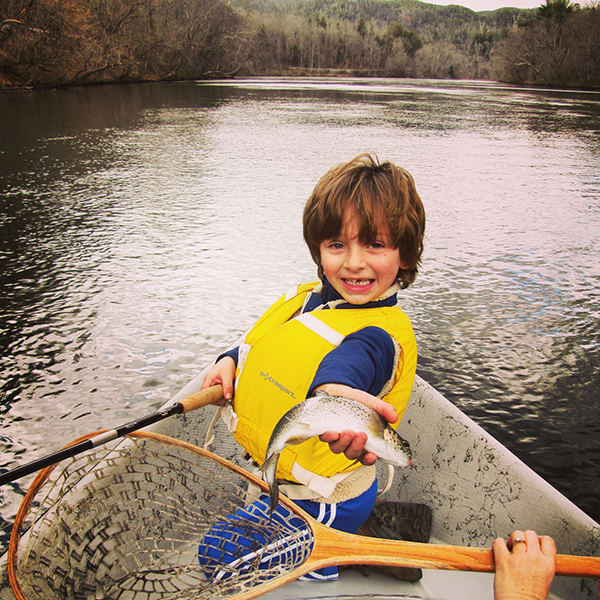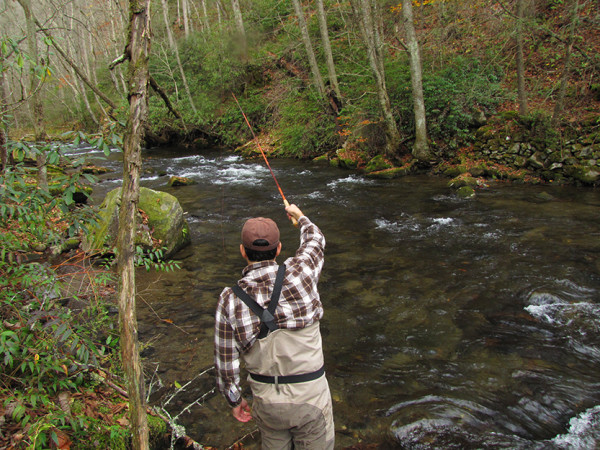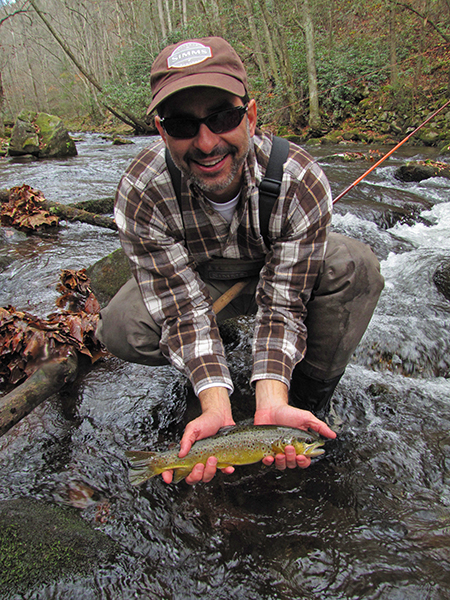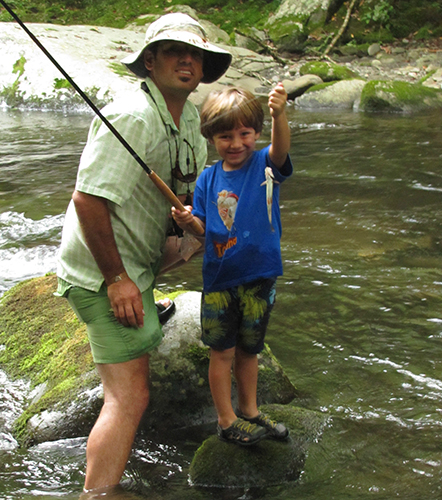We’ve been using Tenkara and used it to guide anglers in the Smokies for about three years now. If you’ve never tried it you won’t believe what an incredibly effective tool it is for fly fishing in rivers and streams. We’ve had a few folks who have booked trips specifically to fish with Tenkara or learn more about it, but we’ll regularly pull a rod out for some spots where it’s much better suited than a traditional fly rod. Virtually every angler we’ve done this with will say something like, “I don’t know how to use a Tenkara rod,” and we’ll respond that if you can use a fly rod you can use a Tenkara rod.
And every one of them has caught a trout with it in just a few minutes.
Over the years we’ve heard the same criticisms of Tenkara again and again, but after plenty of experience with it we feel more than qualified to answer them.
“Tenkara is glorified cane pole fishing.”
Tenkara rods are exceptionally whippy and light unlike the cane pole so often referenced. These rods have such a light action that they moke a 0 weight fly rod seem downright heavy. You have to “fly cast” to get the fly in front of a fish. There is no flipping like you would a gob of worms on a cane pole. I hate to say it, but heavy nymphs and split shots along with strike indicators are flipped on a fly rod very similarly to the old cane pole. Any fly you use with a Tenkara rod must be cast because they’re far too light for a mere flip to work.
“You can’t cast far enough with Tenkara to fish anything other than a small stream.”
This is perhaps our favorite criticism because on almost every guide trip we do either in the Smokies or in the drift boat we almost always ask anglers to shorten their cast. The idea of the long cast is a romantic one as anglers dream of a tight loop cast out 70 feet to a rising trout. The truth of the matter is that long casts, as pretty and macho as they may be, rarely work out on the river. No one can mend line for a good drift at that distance and setting a hook on a long cast is difficult at best and oftentimes hopeless. Shorter casts are easier to control and get successful hook sets. Tenkara keeps anglers in that sweet spot to cast at a manageable distance.

An angler gets a drift to a quiet pocket over swift rapids with a Tenkara rod when his fly rod couldn’t get the drift.
We generally carry two or three leaders for our Tenkara rods to cover different distances and situations. It doesn’t take more than about a minute to change and is much faster than changing out a leader and re-rigging flies on a fly rod.
Perhaps the biggest surprise most anglers experience with Tenkara when fishing in the Smokies is that they can usually fish from further away than they can with a fly rod even though the amount of line is fixed. We prefer 11′-13′ Tenkara rods depending on the location and water conditions. A 12′ rod is our favorite most days in the Smokies and from the end of the rod tip to the fly we usually have about 14-15′ of line. Add that amount of line to the length of the rod and you have a cast well over 20′. You can easily cast further than that in the Smokies with a fly rod but usually have to get closer to get a good drift. Long casts in the Smokies with a 8′ fly rod usually result in a dragging fly.
You can easily rig a leader for longer casts. Many braided lines will come 16′ or longer. Add about 6-8′ of tippet material and cast it with a 13′ rod you’re almost out to 30′. That will work in very high percentage of trout fishing situations.
Tenkara rods provide the absolute best drifts you can achieve with either a dry fly or wet fly and the ultra light line is far less likely to create drag than fly line.
“Tenkara is just for creeks and creek fish.”
We’ll agree that Tenkara isn’t always the best way to fish big rivers, but it’s absolutely viable. We’ve had a blast using Tenkara on our tailwaters and even from the drift boat. Our favorite times to pull out the Tenkara rod is when fish are midging and the flies are small.
“Tenkara is too much of a niche to be widely effective.”
This one is among my favorites since the argument goes that since Tenkara has such a narrow range of flies you can use with it that it isn’t really worth doing. My immediate question in response is “How many fly rods do you have? Do you have a 3 weight? A 5 weight? A 6 weight? A 8 weight?”
The point is that every fly rod is pretty much a niche item. I have several rods I’ve only used in saltwater and a few rods that have never seen anything outside of the Smokies. We have a few rods that do double duty for windy Western rivers and casting popping bugs to smallmouth bass here in Tennessee, but for the most part all fly rods have a job they do best and there are plenty of places where they won’t work well. Tenkara is no different. There are tons of places I love to use it but I’m not going to use it for mega size streamers when chasing striped bass under our local dams. (And a 10 weight fly rod is often not the best tool for that job either!)
“Without a reel there’s no way to catch a big fish with Tenkara”
Well…. This is one criticism where folks will think, “Gotcha there!” but not so fast. First of all it’s extremely difficult for a fish to break a tippet on Tenkara. The rods are so exceptionally flexible that the amount of shock absorption is unbelievable. Furthermore, once a fish runs down a rapid you can’t pull him back upstream no matter what rod you’re using. Even with traditional fly rods you have to chase a big fish either on foot or in a boat. This is especially true in the Smokies. If you hook a big fish you almost never just stand there and let the fish run.
A couple writers at Field & Stream posted a story about catching baby tarpon on Tenkara a few years ago. I’ll even direct you to check out the Instagram feed from the good folks over at Tenkara Rod Co. who made a trip to Alaska a few months back and caught salmon on their rods. Here’s an example…
“Tenkara rods are so light that they’ll kill big fish since you have to play them to exhaustion.”
This is always a controversial topic and it comes up for all kinds of reasons, but it’s really pretty silly when it comes to Tenkara. Since there isn’t a reel the fish can only get so far from you. It’s not like it’s going to make another long run. You will need a net if you’re chasing bigger fish with Tenkara, but since the fish is only a limited distance from you at any time you will be able to land it sooner than you would with a rod that has a reel.
Tenkara rods are so light you need to use light tippet just so the tippet breaks before the rod tip. If anything, your tippet should break on a big fish well before it’s in any danger of dying from exhaustion.
A few other things you may not have thought of
As we head into winter there are a few things to consider about Tenkara. Since there is no line to strip you don’t need to strip line. This keeps you hands much warmer, you can even use mittens and even keep one hand in your pocket. Furthermore, there are no line guides to freeze up.
Tenkara is a much less expensive way to fly fish since there are no reels or vinyl fly lines. The lines used with Tenkara are at least as durable as fly line if not more and cost a mere fraction.
The compact nature of Tenkara rods makes them very easy to take on hikes or camping trips not to mention just keeping them in the car to fish when the opportunity arises. We’ll take hikes with our kids and bring the Tenkara rod out for a few minutes at a time since kids’ attention span don’t usually keep them interested in fishing all day long. We can keep the rod down in the pack but quickly set it up for a few good runs of water, then easily put it back in the day pack when the kids are ready to move on.
The extra length of these rods also makes it easy to fish smaller trailside streams without waders. You may not be able to fish every last bit of water, but you will be able to walk further to fish without the additional weight and hassle of carrying extra boots and waders.
If you break the tip of a Tenkara rod it is pretty easy and inexpensive to replace without sending the rod back to the manufacturer. Since the rods telescope each piece is separate. All you have to do is unscrew the butt cap on the handle, let the broken tip slide out, then replace it with a new tip.
A few admissions…
In all fairness, I will address a few things that are difficult with Tenkara. It is extremely difficult to use if wind is an issue, but at the same time fly rods and wind have never really gone together nicely.
If you’re into using big nymphs with split shot or big, articulated streamers with sinking lines, Tenkara won’t do that. However, we regularly use nymphs with our Tenkara rods, just don’t add any split shots or strike indicators. This is a major turn off for some anglers but I’ve always looked at strike indicators as a tool. I prefer fishing without them when I fish on my own in many places, although I use them about 99% of the time when guiding.
Tight line or Euro nymphing as it’s often called is incredibly effective with Tenkara rods. We prefer to use shorter lines than with dry flies. Most people are amazed how easy this style of nymphing can be. This can be done with wet flies, beadhead nymphs, or any basic nymph pattern.
There has been a lot of attention made out of the fact that Tenkara is so simple even children can do it unassisted in just minutes. That may be true at times, but can also be just as frustrating as learning to cast a fly rod some people if they’ve never done that. Anyone who can cast a fly rod will do just fine with Tenkara right away. If you never done any fly casting it probably takes about the same amount of frustration. Some folks take to it right away while others take a little longer to get the feel. The most common mistake for beginner fly casters is putting way to much force into a cast. Ultra light Tenkara rods are even easier to overpower than fly rods. However, once that part is figured out it is absolutely less complicated than using a fly rod.
The main reason for this is that there is no mending line or stripping line with Tenkara. This is always a tough thing for folks to figure out with a fly rod but unnecessary with Tenkara.
Anyone who fly fishes our home waters in the Smokies is well acquainted with all the stream side vegetation we have and overhead cover from trees. This will be the biggest thing to get used to with a longer rod. Even with fly rods we’ve always preferred longer rods and that’s what initially drew us to Tenkara. Setting the hook on a fish and bringing them in will take a little bit of an adjustment as you learn to handle it in this environment, but even that isn’t all that hard. It just takes a little bit of practice and that’s the fun part.






Bigsur says
Great article, covers all the basic info in one report. I have fished Tenkara mainly in the park the last 4 years and enjoy it. Do I use it all the time…no…but when conditions prevail or just want to break up the monotony of same old same old; it’s a blast. Thanks for this article!
Ian says
We find ourselves using it more and more. There are a number of times when the fishing is OK, but not great. It seems like those extra good drifts pull a few more strikes. Could be our imagination, but when you’re guiding on a tough day it’s always nice to have something else to fall back on. I think a “poor” cast with Tenkara is less likely to spook fish too since the line is so light.
Thanks for the comment!
Shawn Rhoderick says
Ian,
Please forgive me for typing Brian instead of Ian. I had just emailed Brian at Mad River Outfitters and had his name in the front of my thick cranium.
Shawn
Ian says
No problem, Shane…. Err, Shawn..
Thanks for the comment!
Ian
Shawn Rhoderick says
Brian and Charity,
I appreciate your well thought out responses to the common misconceptions associated with tenkara. I have enjoyed fishing for trout in TN, NC, WI, and MI with tenkara rods. I have caught panfish, smallmouth,and even a channel cat with tenkara. You are absolutely correct in saying that tenkara is not always the best fit in all fishing situations, but there are plenty of scenarios where tenkara is the perfect way to present your fly, catch fish, and truly enjoy your fishing experience.